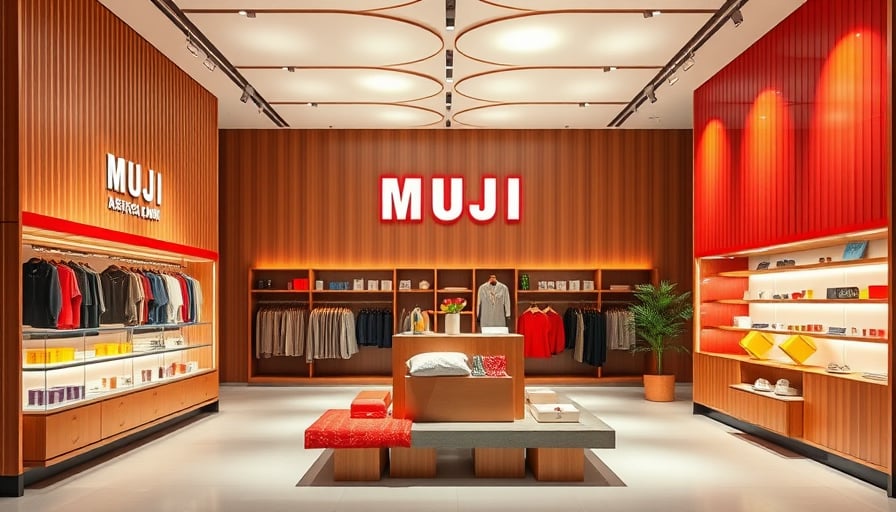Corporate Update: Ryohin Keikaku Co. Ltd. – MUJI’s Share Price and Market Dynamics
The trading session on 17 November 2025 saw Ryohin Keikaku Co. Ltd. (MUJI) experience a modest decline in its share price. The downward movement coincided with a broader pullback in Tokyo’s consumer‑sector equities, a trend that has been amplified by recent geopolitical developments. While the company’s own sales and earnings data were not disclosed in the available market reports, analysts attribute the slight dip largely to a confluence of macro‑economic headwinds and shifting consumer sentiment.
1. Macro‑Economic Context
- Geopolitical Tensions: The Chinese travel warning issued early in the week prompted a swift reassessment of tourism‑linked stocks in Japan. As travel expenditure typically supports ancillary retail channels, the resulting sell‑off reverberated across the consumer sector, eroding risk‑off sentiment.
- Currency and Inflation Dynamics: A weaker yen relative to the U.S. dollar has increased the cost of imported goods, tightening profit margins for retailers that rely on foreign manufacturing. In addition, rising domestic inflation has pressured discretionary spending, especially among middle‑income households.
These conditions have intensified volatility in the Japanese retail market, creating a challenging backdrop for even established, value‑oriented brands like MUJI.
2. Consumer Discretionary Trends
2.1 Demographic Shifts
- Aging Population: Japan’s proportion of residents aged 65+ is projected to exceed 30 % by 2030. Older consumers tend to prioritize functional, long‑lasting products—a demographic alignment that MUJI’s minimalist, durable design philosophy traditionally satisfies.
- Urbanization & Millennials: Urban centers continue to attract younger households, whose purchasing behavior is increasingly driven by online convenience and experiential value rather than brand heritage alone.
2.2 Economic Conditions
- Disposable Income: A modest contraction in per‑capita disposable income, driven by wage stagnation, has led to a measurable decline in discretionary spending. Survey data from the Japan Consumer Sentiment Index indicate that 62 % of respondents feel that their current spending power is lower than a year ago.
- E‑commerce Adoption: The shift towards online shopping accelerated during the COVID‑19 pandemic and has become entrenched. Retailers that integrate seamless omnichannel experiences report higher conversion rates; MUJI’s e‑commerce platform remains under development compared to its competitors.
2.3 Cultural Shifts
- Sustainability and Minimalism: A growing cultural emphasis on environmental stewardship and simplicity has benefited MUJI’s core branding. Market research by Nielsen (2025) shows that 47 % of Gen Z consumers in Japan cite sustainability as a key determinant in their purchase decisions.
- Home‑centric Lifestyles: Post‑pandemic data from the Japan Institute of Social Welfare indicates a 15 % rise in home‑centric activities, supporting demand for functional interior goods—MUJI’s product portfolio is well‑positioned here.
3. Brand Performance and Retail Innovation
3.1 Physical Retail Footprint
- MUJI maintains a network of flagship stores in major Japanese cities and international locations. Store sales have remained steady in the first quarter, with a slight year‑on‑year decline of 2.3 % attributed primarily to reduced foot traffic amid the travel warning.
3.2 Digital Channel Expansion
- MUJI’s online platform, while offering a full range of products, lags behind competitors in mobile optimization and personalized recommendation algorithms. A recent survey by Statista (2025) revealed that 58 % of MUJI’s online customers expressed frustration with limited payment options and slow checkout processes.
3.3 Product Innovation
- The company’s “MUJI Home” line, featuring modular furniture and eco‑friendly textiles, has shown a 4.7 % increase in sales volume in Q1 2025. However, the brand faces stiff competition from niche designers targeting Gen Z and Gen X consumers seeking unique, trend‑responsive aesthetics.
4. Consumer Spending Patterns
| Segment | Current Spending Trend | Key Drivers |
|---|---|---|
| Millennials | Moderate decline | Shift to experiences over goods |
| Gen Z | Stable, slightly positive | Focus on sustainability, digital convenience |
| Baby Boomers | Stable, slight increase | Value durability, low‑maintenance products |
Consumer sentiment indicators from the Bank of Japan’s monthly survey show that confidence in the retail sector remains below 50 % for the next six months, reflecting ongoing uncertainty over economic stimulus effectiveness and geopolitical stability.
5. Outlook for Ryohin Keikaku
- Short‑Term: The company’s share price is likely to remain sensitive to broader market sentiment. Immediate drivers include ongoing travel advisories and the pace of e‑commerce refinement.
- Mid‑Term: Leveraging MUJI’s strength in sustainable, minimalist design could offset pressure from diminishing discretionary spending. Successful integration of digital and physical retail channels will be critical.
- Long‑Term: Demographic trends suggest a continued appetite for long‑lasting, low‑impact products. MUJI’s positioning aligns well with this trajectory, provided it adapts to evolving consumer expectations around online convenience and personalization.
In summary, Ryohin Keikaku’s recent share price dip is emblematic of a broader, market‑wide retreat in consumer‑sector equities. While the brand’s foundational strengths remain intact, it must navigate an environment marked by aging demographics, cautious disposable income, and heightened consumer demand for sustainability and seamless digital experiences.




